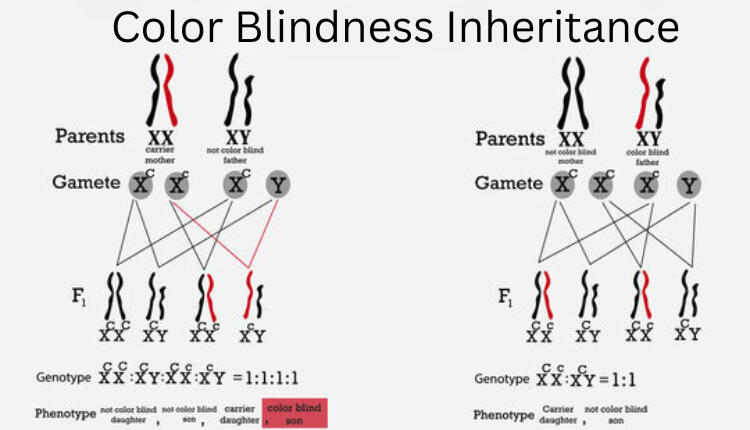Color Blindness Inheritance Using Punnett Square
Color blindness (color vision deficiency, or CVD) affects around 1 in 12 men (8%) and 1 in 200 women. In the UK, there are about 3 million color blind people (about 4.5% of the entire population), and most of them are male. Across the globe, there are estimated to be 300 million people with color blindness, almost the same number of people as the entire population of the USA!
What causes color blindness to occur?
There are various causes of color blindness. For most color blind people their disease is genetic, usually inherited from their mother. Although some people become color blind as a result of other diseases, such as diabetes and multiple sclerosis or it can be gained due to aging or from consuming drugs and medications.Color blindness can also occur if your eyes or the part of your brain that allows you to see color gets damaged. This can be caused by:
Eye diseases, like glaucoma or macular degenerationEye diseases, like glaucoma or macular degeneration
Brain and nervous system diseases, like Alzheimer’s or multiple sclerosis
Some medicines, like Plaquenil (a rheumatoid arthritis medicine)
Eye or brain injuries
Your color vision may also get worse as you grow older, especially if you get a cataract — a cloudy area in your eye.
Inheritance Of Color Blindness

Color blindness is a condition that is passed from parents to their children through genes called chromosomes.Some of these are called X and Y chromosomes which help in determining if you are male or female at birth. Males only have 1 X chromosome and 1 Y chromosome, and females have 2 X chromosomes. The genes that can give you red-green color blindness are passed through the X chromosome.For example, if a mother is a carrier for color blindness (X+Xc), and a father has normal vision X+Y, then their sons have a 50% chance of color blindness because they inherit their X chromosome from their mother and their Y chromosome from their father.Since it is passed through the X chromosome, red-green color blindness is more common in men. This is because:
Males carry only 1 X chromosome from their mother. If that X chromosome carries the gene for red-green color blindness (instead of a normal X chromosome), they will have red-green color blindness.
Females carry 2 X chromosomes, one from their mother and one from their father. To be colorblind to red-green, both X chromosomes would require to have the gene for red-green color blindness.
Blue-yellow color blindness and complete color blindness are carried by other chromosomes, so they affect both males and females equally.
X-linked inheritance
X-linked inheritance patterns vary depending on the type of inheritance. Recessive X linked conditions are always passed through the maternal line with the condition appearing in males and being carried in females, but not usually said.Dominant X-linked diseases can be carried by either affected parents to their children. If the father has the affected components of the gene he will just pass out the disease to his daughters and not his sons. Mothers can transfer X-linked dominant conditions to both their sons and daughters. Examples of X-linked conditions have Haemophilia and Duchenne muscular dystrophy.
Y Linked Inheritance
Y linked inheritance is also known as the inheritance of genes on the Y chromosome. As only males have a Y chromosome, Y-linked genes can only be transferred from father to son. Y-linked inheritance is also called the holandric inheritance.Humans and other various mammalian males have sex chromosomes such as the X and Y chromosomes. The Y chromosome is normally smaller than the X chromosome and therefore, carries somewhat fewer genes. Besides, the genes for sperm development, specific hormonal output, and other features characterizing males, the Y chromosome also carries genes other than for sex determination.
How is a Punnett square for color blindness created?
Punnett squares are just a way of organizing all the genes and figuring out how probably a combination of genes is. For your current situation, if we assume that you are not a carrier of a colorblindness gene, then we would say you are XX. (This just means you have 2 “normal” X chromosomes, at least as far as colorblindness is discussed.)We would say your husband is XcY means that he has a component of the gene that causes colorblindness on his X chromosome and a Y chromosome. To make the Punnett square, we will put your husband’s two likely contributions, Xc and Y on the top and your two, X and X on the left side like this:

In each square, we just merge the genes that come together in that square. That'll give the following Punnett square:

As you can see, all of your daughters, XXc, end up having the colorblindness gene. None of your sons have it because they can only get an X from you. However, since each daughter also has a good copy of the gene, they are not colorblind themselves but are carriers of color blindness.Now, what if your daughters had children with men, who weren’t colorblind? Then their Punnett square would look like this:

As you can see, there would be a 1 in 4 or 25% chance for a daughter who is a carrier (XcX), a 25% chance for a colorblind son (XcY), and a 50% chance for a child without the colorblind gene (XX, XY). And what if your daughter had children with a colorblind man? Then it would look like this:

Now there would be a 50% chance for a colorblind child (XcXc, XcY), a 25% chance for a daughter who is a carrier (XcX), and a 25% chance for a colorblind-free son (XY). I hope this helps.
Conclusion
If you simplify genes down to a Punnett square you can make one for the majority of color blind people who are color blind due to an X-linked recessive mutation. However, color blindness outside of Punnett squares is not that simple. Not all color blindness is due to an X-linked genetic mutation. The human genome project found 56 gene mutations on 19 chromosomes capable of causing colorblindness.